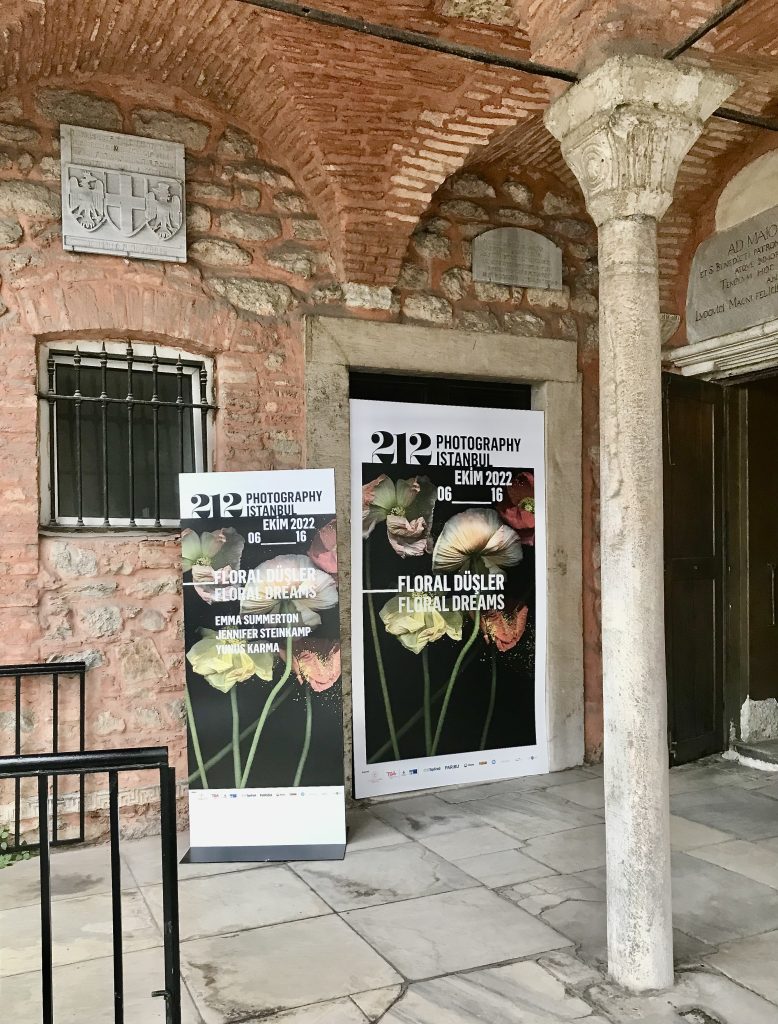Old name: Karay Köy
The waterside suburb of Karaköy almost feels like four separate places. There’s Karaköy Meydanı, the frantically busy square through which the trams and buses run after crossing the Galata Bridge and which is probably seen by most visitors to the city at some point during their stay. Then there is the harbour area where the ferries from Üsküdar and Kadıköy tie up and disgorge thousands of passengers. This, too is probably seen by many visitors to the city.
But then there is the part of Karaköy that lies east of the ferry terminal. This is where cruise ships used to dock although they now drop anchor a little further east at the big new Galataport. Until recently this was an area of small art galleries, quirky shops and delightful cafes but in the way of things they are being squeezed out as the value of the land rises exponentially and the chain stores move in. Hello, Starbucks!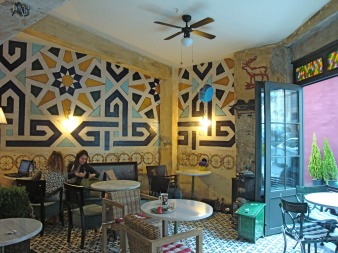 Karabatak (Cormorant) Cafe
Karabatak (Cormorant) Cafe
Finally, there is Voyvoda (Bankalar) Caddesi on the opposite side of Karaköy Meydanı . Once the heart of 19th-century Constantinople’s banking industry, it’s lined with wonderfully grand buildings that are being turned into hotels and galleries now that the banks have shipped out to Levent and Ataşehir.
Karaköy is one of the most fascinating parts of İstanbul when it comes to minor historic monuments. Its streets are home to a diverse selection of old mosques, synagogues and churches, some of them even on the roofs of other buildings. For the time being it also retains something of the rawly authentic feel of an area where people are still going about workaday businesses. The myriad hardware stores on the southern side of the Galata Bridge are an institution. Visit soon. Complete change is imminent.
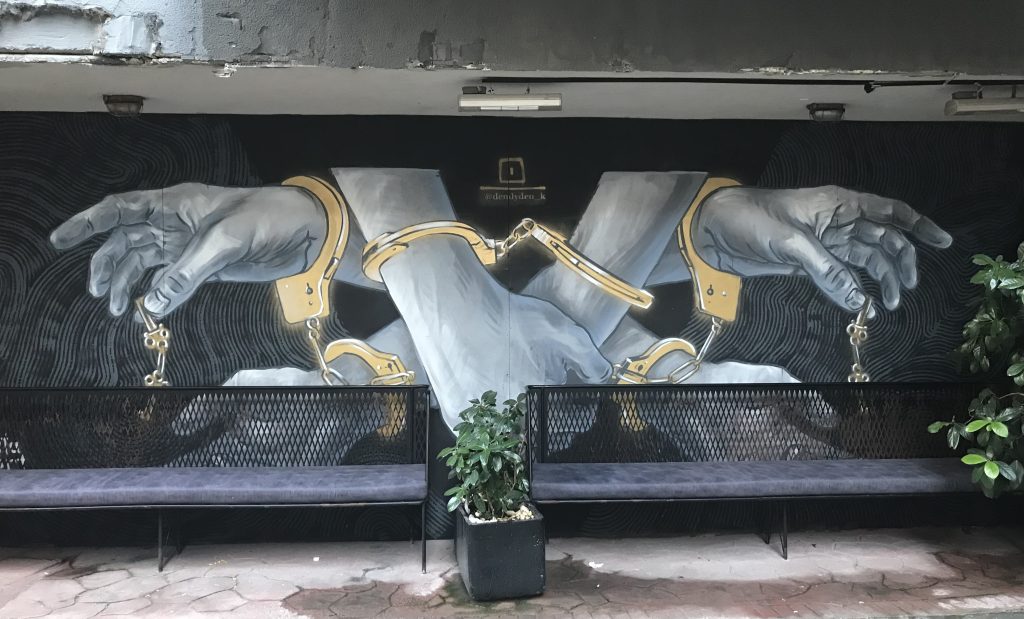
Around Karaköy Meydanı
As you get out of the tram in Karaköy you will see on either side of the road some of the grand buildings created in the late 19th and early 20th century to house banks and other businesses. Some, such as the Karaköy Palas (1920), are still in the same use today. Others, such as the Nordstern Han (1889), are being found new uses, in its case as a hotel. 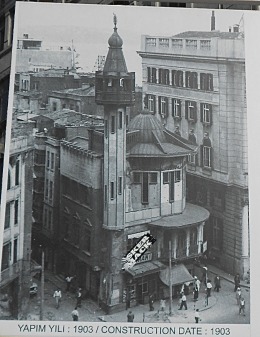
On the harbour side of the square once stood the small Merzifonlu Kara Mustafa Paşa Cami designed in 1903 by the Art Nouveau architect, Raimondo d’Aronco. When the road was being widened in 1956 it was taken down stone by stone with the intention of rebuilding it on Kınalıada. Unfortunately the boat carrying the stones then sank, scuppering the plan. More recent plans to rebuild the mosque in its original position appear to have come to nothing.
On the opposite side of the square and very easy to miss in a narrow side street near the Karaköy entrance to the Tünel funicular is the old Zülfaris (“Bridal Curls”) Synagogue that used to house the Jewish Museum, now moved to Neve Shalom in Galata. The building went up in 1823 on the site of an earlier synagogue; its restoration was paid for in 1890 by the wealthy Kamondo family whose money also gifted us the Nordstern Han and the nearby Kamondo Steps.
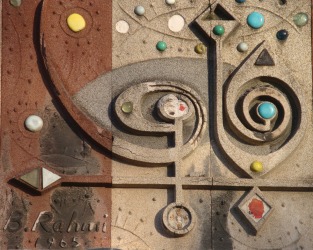 Easy to overlook and increasingly vulnerable as urban regeneration races ahead is a long stone mosaic running along the facade of the nondescript shops and restaurants on the harbour side of the square. Look closely and you’ll see the signature of the famous poet-artist, Bedri Rahmi Eyuboğlu (1911-75). Then step inside what is now a branch of Murat Muhallebicisi (Pudding Shop). On the back wall is a superb red and gold mosaic created for the shop by the same artist in the days when it was a simple butcher’s shop.
Easy to overlook and increasingly vulnerable as urban regeneration races ahead is a long stone mosaic running along the facade of the nondescript shops and restaurants on the harbour side of the square. Look closely and you’ll see the signature of the famous poet-artist, Bedri Rahmi Eyuboğlu (1911-75). Then step inside what is now a branch of Murat Muhallebicisi (Pudding Shop). On the back wall is a superb red and gold mosaic created for the shop by the same artist in the days when it was a simple butcher’s shop.
Along Voyvoda (Bankara) Caddesi
Voyvoda Caddesi is the street that runs uphill towards Galata from immediately behind the Tünel. Narrow and darkened by the tall buildings on both sides of the road, it is a fascinating mishmash of the architectural styles that were battling for supremacy in late 19th-century Constantinople including designs by Giulio Mongeri and Alexandre Vallaury. The single most important building is the one designed by Vallaury in 1892 to house the Ottoman Bank that played an important role in keeping the late Ottoman Empire financially afloat. It’s worth dropping in to take a look at the banking museum (open daily, admission free) in the basement.
The building is also home to the flashy SALT gallery, an arts research centre with a library and café. It was designed by a team of seven architects in 2010.
On the opposite side of the road are the lovely curvaceous Kamondo Steps, probably paid for by a member of the wealthy banking family, the Kamondos, in the 1880s. Famously photographed by Henri Cartier-Bresson in 1964, today they’re almost constantly covered with selfie-seekers.
Having trouble finding the street? Then look for the Minerva Han on the edge of Karaköy Meydanı as the main road turns right towards Tophane. Running beside it is Yüksek Kaldırım (High Pavement), the steep direct route up to Galata that used to be lined with 118 steps (and used to be part of İstanbul’s red light district). The Minerva Han is to the left of Voyvoda Caddesi which takes a gentler, if more circuitous route up to Galata. It was designed for the Deutsche Bank in 1912-13.
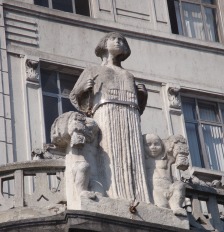
Around Karaköy ferry terminal
If you head down to the ferry terminal from Karaköy tram stop you will pass in front of the imposing TC Ziraat Bankası building, built for the Vienna Bank in the early 20th century and decorated with two figures that are amongst the earliest examples of figurative sculpture in the city. It is currently under restoration.
A street lined with restaurants and cafes runs alongside the waterfront offering a wonderful view across the water to Sarayburnu (Seraglio Point), Topkapı Palace and Ayasofya as well as the Sepetçiler Kasrı, a pretty stone pavilion on the waterside at Sirkeci. You might also want to admire a cluster of fine buildings in the Early Republican style known as First National Architecture opposite the ferry terminal. A memorial behind the habitual row of fishermen commemorates the fact that it was from here on 16 May 1919 that Atatürk embarked on the Bandırma in the first step (ilk adım) of the Turkish War of Indendepence.
Immediately behind the cobbled street and running parallel with it is another narrow street which still throbs with ordinary businesses catering, for example, for local fishermen. At the Karaköy Meydanı end of it the fine Ömer Abed Han was designed by Vallaury and has his signature engraved on it in stone. Keep walking and you will come to the Yeraltı Cami (Underground Mosque) built to house the remains of two Arab holy men believed to have taken part in an effort to capture Constantinople in the 7th century. It stands on the site of a tower to which would have been attached one end of the chain used to close off the Golden Horn to shipping in Byzantine times.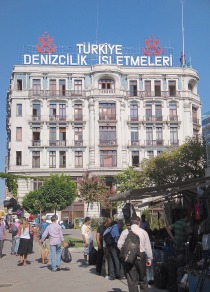
The two parallel streets emerge in a small square facing what was once the grand office of the Turkish Maritime Lines (Türkiye Denizcilik İşletmeleri) built between 1912 and 1914. It has now been absorbed into the Peninsula Hotel.
Turn left here and you will see the Kermankeş Cami with a beautiful fountain (1732) against its outside wall. Founded in 1643 by the grand vizier Kermankeş Mustafa Paşa, it apparently stands on the site of a 14th-century Catholic monastic complex that closed in 1606. Above the fountain the associated primary school (sıbyan mektebi) juts out on brick corbels. Beside it there is a fine view up to the Galata Tower.
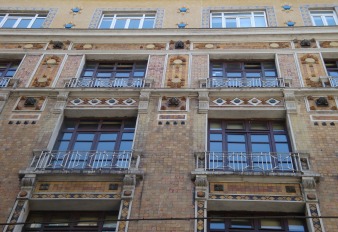 Old Customs House
Old Customs House
Around Mumhane Caddesi
Perhaps the most intriguing part of Karaköy lies in the labyrinth of streets behind the old port buildings. You will find it by walking along the road running beside the Turkish Maritime Lines building parallel to the waterfront.
On the inland side of the street stands the Karaköy Lokantası housed in a lovely building that served as the Estonian Consulate from 1936 to 1940.
Across the road, the arrivals area of the old port building now forms part of the Peninsula Hotel as does the adjacent colourfully tiled Customs House built in 1911 and facing a tiny garden. 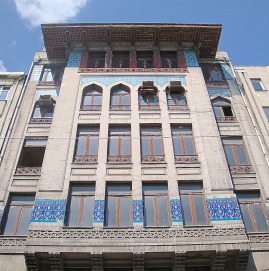 Ovacimyan Han by Nafilyan, 1920s
Ovacimyan Han by Nafilyan, 1920s
Facing the Customs House and in the side streets nearby are several more fine examples of First National Architecture, some of them currently under restoration. Then you will see on the water side of the road the beautifully restored long building that was for many years the main parcel sorting office and now offers access to the Galataport.
Facing it across the street is the Cite Francaise shopping arcade. Just beside it is the highly decorative mid-19th-century facade of the Voyvoda (Aziziye) Karakol (Police Station). It’s still in use so don’t be tempted to take any pictures.
If you walk through the arcade you will emerge in Galata Mumhane Caddesi whose name suggests that candles were once manufactured here. It is here and in parallel Ali Tahşın Sokak that you will discover the many hidden churches that are a characteristic of this neighbourhood.
The most conspicuous is what started life in the 16th century as the Greek Orthodox Church of Panagia Kafatiani (St Mary), was completely rebuilt in 1840 and is now the only church of the obscure, not to mention politically dubious, Turkish Orthodox Church, whose congregation appears to consist of just one family, the Erenols, their deceased patriarchs buried in the Greek orthodox Cemetery in Şişli. The body of the church is usually locked but you’re welcome to wander into the icon-filled narthex where you’ll see one of the model boats often left as a thanks offering to St Nicholas by grateful mariners and possibly brought here from the nearby Church of St Nicholas which was also acquired by the Turkish Orthodox church in 1922 but is now permanently locked (part of it now houses a soup shop).
The flagstoned courtyard contains the gravestones of many Ottoman Greeks although its most obvious feature is usually a huge banner reading “Ne Mutlu Türküm Diyene (How Happy is He Who Can Call Himself a Turk)”.
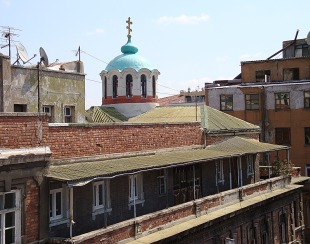 Far harder to spot are four small gems of ecclesiastical architecture built between 1870 and 1880: the rooftop churches of the Russian Orthodox Church that were used by pilgrims on their way to Jerusalem or Mt Athos. Each boasts a small cupola, the only external clue to their existence. Beneath each of the churches there used to be a “podvoriye“, a dormitory where pilgrims could break their journey overnight.
Far harder to spot are four small gems of ecclesiastical architecture built between 1870 and 1880: the rooftop churches of the Russian Orthodox Church that were used by pilgrims on their way to Jerusalem or Mt Athos. Each boasts a small cupola, the only external clue to their existence. Beneath each of the churches there used to be a “podvoriye“, a dormitory where pilgrims could break their journey overnight.
Today Sunday services are still held in St Pantaleimon (1878,) which is full of modern icons, and in St Andrei’s (1870) which was beautifully decorated with paintings of the saints against a deep-blue background by the famous Russian Symbolist artist Mikhail Vassileyevich Nesterov (1862-1942). In 2013 a service was also held to reconsecrate St Ilya (Elijah, 1879) for fear that it would be lost to the redevelopment going on all around it. The Triotskoye (Trinity, 1880) has been closed for many years.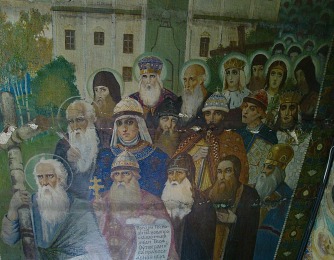
But the most obvious of Karaköy’s many churches is out on Kemeraltı (Tophane) Caddesi, the road along which the tram runs. The enormous Armenian Orthodox Church of Surp Krikor Lusavoriç (St Gregory the Illuminator) was designed in 1966 by Bedros Zobyan using the Armenian church at Echmiadzia as a model. It replaced a church dating back to 1431 which had been built on land bought by the Armenians from the Genoese which was finally demolished in 1958 to make space for a wider road. In 2013 the church reopened to the public after restoration. It is the only church in İstanbul with the familiar high-sided Armenian dome.
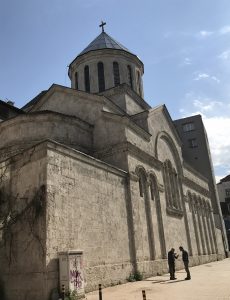
There are two other interesting churches on Tophane Caddesi although you’re unlikely to be able to see inside either of them. The first is up a flight of stairs near St Benoit High School. The Church of Surp Hisus Pırgiç (Jesus Christ the Saviour) was built in 1834 for a breakaway group of Armenian Catholics who had sworn allegiance to the Pope since the 18th century. Externally austere, it is said to have an elaborately decorated interior.
The second church actually forms part of the property of St Benoit High School and dates right back to 1427 when it was founded by Benedictine monks. In 1583 the Church of St Benedict was taken over by the Jesuits who set up a boys school here. Then in 1773 it was passed to the Lazarists. In 1839 a girls school was added to the site which merged in 1987 to form the modern co-ed high school. Buried inside the beautiful church are several early French ambassadors to Constantinople.
Eating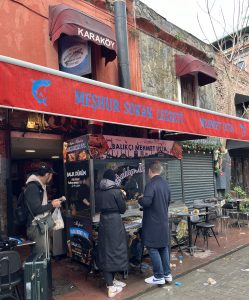
Mumhane Caddesi features all sorts of dining opportunities including the popular street food vendor, Meşhur Sokak Lezzeti Mehmet Usta, who attracts queues for fish wraps grilled in spices to a special recipe. Not far away a soup shop hunkers down in an abandoned church.
But Karaköy has also sprouted its own trendy take on cafe society.
Dem Immediately opposite the locked Church of St Nicholas this popular little cafe specialises in serving teas from all round the world. You can even get an English-style cream tea with scones here. Hoca Tahşın Sokak No. 17 Tel: 0212-293 9792
Karabatak (Cormorant) Karaköy Bringing the taste of Viennese Meinl coffee to the locals of backstreet Karaköy, this gem of a café sprawls out onto the pavement although the shabby-chic interior is pretty inviting too. Kara Ali Kaptan Sokak No. 7, Tel: 0212-243 69 63,
Namlı Gürme On a Sunday morning impressive queues form outside this popular deli, a bigger version of the small one in Tahtakale. The draw? Super-popular breakfasts that can be eaten on the pavement on nice days. Mumhane Caddesi No, 6, Tel: 0212-293 6880
Ops (Oops) Cafe Stylish exposed brick-and-pipes interior with sofas, armchairs and long tables to spread yourself out over a coffee break or evening meal. Lots of laptop action attests to its popularity with the locals. Mumhane Caddesi, Nimet Han No.45/B, Tel: 0212-245 02 88
Sleeping
Galatahan. Tel: 0212-208 2222
Gradiva Hotel. Tel: 0212-249 7700
JW Marriott Istanbul Bosphorus. Tel: 0212-806 2020
Nordstern Hotel Galata. Tel: 0212-358 2222
Novotel. Tel: 0212-372 0700
The Bank Hotel. Tel: 0212-283 0055
Transport info
The tram from Sultanahmet stops at Karaköy. An underpass takes you to the Karaköy (Lower) station of the Tünel funicular up to İstiklal Caddesi.
Frequent ferries from Karaköy head for Kadıköy with rather fewer for Üsküdar. Once-hourly ferries head for the Golden Horn.
Nearby areas
Read more about Karaköy: http://www.turkeyfromtheinside.com/blogbloggingaboutturkey/entry/15-religious-squabbling-the-hidden-churches-of-karakoy-.html
